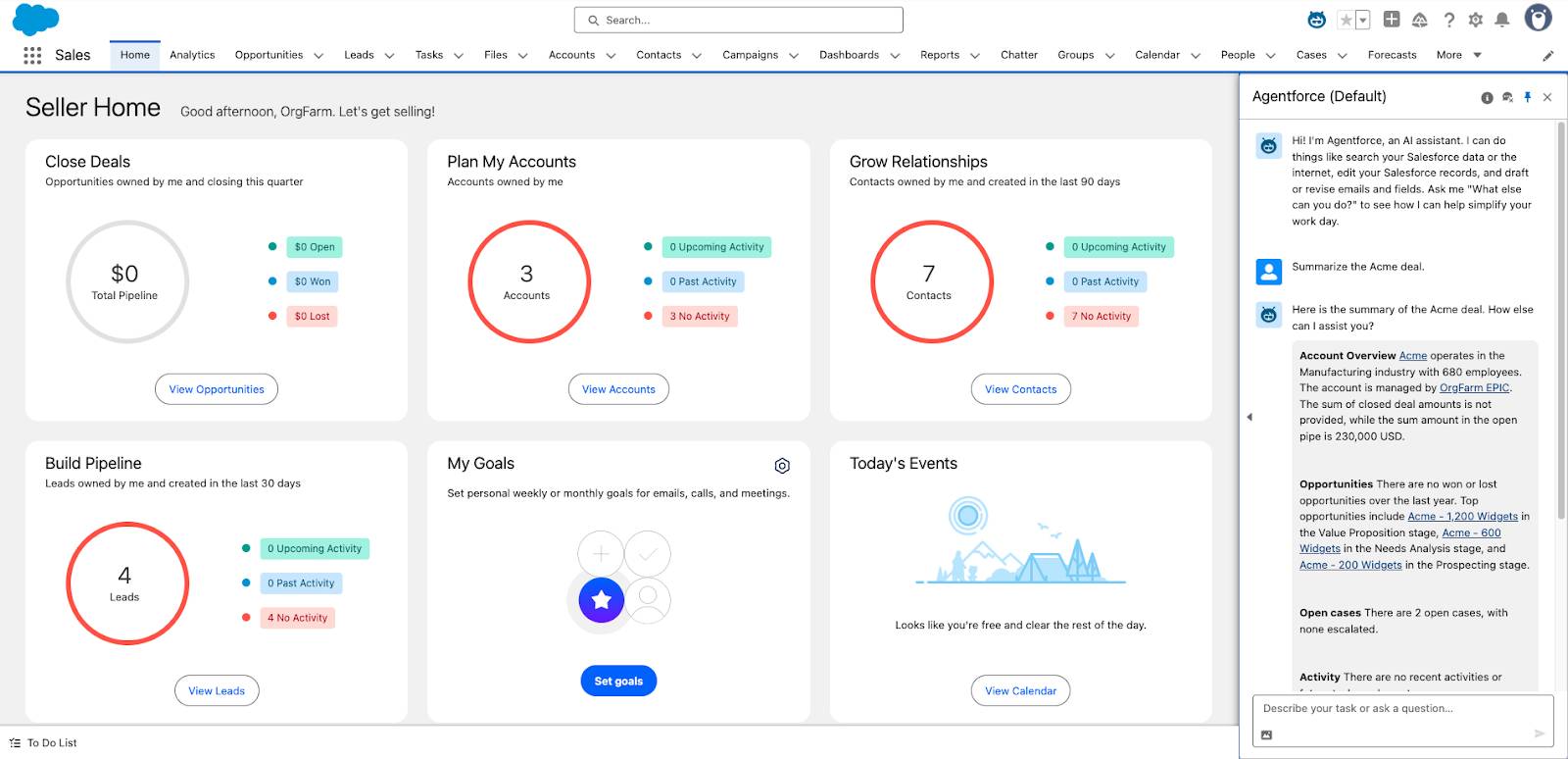Get Started with Agentforce
Learning Objectives
After completing this unit, you’ll be able to:
- Explain what Agentforce is.
- Identify the main characteristics of Agentforce.
- List a few use cases for Agentforce.
Before You Start
Before you start this module, consider completing this recommended content.
The Hero of Our Journey
Meet Linda Rosenberg, the Salesforce admin at Cloud Kicks. Cloud Kicks sells stylish and comfortable custom sneakers, and the company is growing fast. Linda is always looking for ways to better serve customers and make work easier for Cloud Kicks employees. She’s excited about the value that Agentforce provides.
Linda aims to boost employee productivity by automating time-consuming and repetitive tasks, freeing people up for more strategic activities. She also wants to provide more personalized responses to customers, ensuring they get the help they need.

One day, a customer, Alex, reaches out to Cloud Kicks with a series of questions. Here’s how the interaction currently unfolds without Agentforce.
Customer (Alex): "Hi, I just placed an order for a pair of custom sneakers. Can you tell me when it will be delivered?"
Customer service representative (CSR): “Hello, Alex! Your order will be shipped within the next 2 to 3 business days and should arrive at your address within 5 to 7 business days after shipping.”
Alex: “Thanks! Do you have any stores in New York City?”
CSR: “I’m not sure. Let me check our store locations. One moment, please.”
CSR, after a long pause: “I couldn’t find any information on stores in New York City. You might want to check our website for more details.”
Alex: “All right, thanks. One more thing—do you have any recommendations for a good running trail in New York City?”
CSR: “I’m sorry, but I don’t have that information. I suggest checking a local running club or a tourism website for recommendations. Do you have any other questions?”
Alex: “No, that’s all. Thanks for your help.”
CSR: “You’re welcome, Alex. Have a good day!”
Alex might be amiable, but this conversation highlights the challenges of automated customer service without comprehensive information and real-time data access. Delays and incomplete answers dampen the customer experience.
Linda is thrilled about Agentforce’s potential to transform customer interactions. With Agentforce, customer service becomes more autonomous while delivering relevant information. Agentforce ensures every interaction is smooth, efficient, and helpful.
Meet Agentforce
Agentforce is a customizable suite of autonomous and assistive artificial intelligence (AI agents). AI agents are goal-oriented AI applications that perform tasks and business interactions. Designed to make intelligent decisions, Agentforce can initiate and complete a sequence of tasks, handle natural language conversations, and securely provide relevant answers drawn from business data. Whether your users are on a desktop or mobile device, Agentforce is there to help across a wide range of workflows and interactions.

Best of all, you don’t need to know a stitch of code to set up an AI agent in Salesforce. All you have to do is enable Agentforce and then create an agent. Here are some actions an AI agent can take out of the box.
- Summarize Salesforce records, such as opportunities, accounts, and cases.
- Draft or revise emails.
- Find and update Salesforce records.
- Aggregate Salesforce data.
- Answer questions with information from your knowledge base.
On top of that, it’s easy to extend your AI agent by using your existing Salesforce Platform. For example, if you already have a flow in Salesforce that makes product recommendations, you can add that capability to an agent with just a few clicks.
Agentforce Characteristics
Let’s take a closer look at each characteristic of Agentforce so you can get more familiar with your new digital companions.
Trusted
At Salesforce, Trust is our #1 value. That’s why we build generative AI tools like Agentforce with Trust at the core.
Your AI agents respect Salesforce’s standard access controls, ensuring secure actions. Agentforce integrates with the Einstein Trust Layer, a secure AI architecture built into the Salesforce Platform. You get the benefits of generative AI without compromising customer data, and you can use trusted data to enhance AI responses.
Here’s how it works:
-
Data grounding: The Trust Layer grounds and enriches generative prompts with trusted company data.
-
Zero-data retention: Your data stays safe; it’s never retained by third-party large language model (LLM) providers.
-
AI monitoring: AI interactions are logged, giving you visibility into each user interaction.
For critical scenarios where accuracy is key, agents can seamlessly transfer the conversation to a human. For example, if a user needs help with a complex issue like resetting a password and prefers a human touch, an agent verifies their identity, then promptly transfers the conversation for personalized support.
Proactive
Some AI agents aren’t just reactive, they’re proactive, which is essential in dynamic business environments. AI agents use the reasoning engine in Agentforce to perform the reasoning and acting process. The reasoning engine helps agents automate routine tasks, handle tedious duties, and find the right solutions for customers. This simplifies the process for service reps at Cloud Kicks, making their jobs easier and more efficient.
Here’s how AI agents use reasoning to enhance these actions.
Case Status Update:
-
Reason: The agent reviews the case context, current status, and recent updates.
-
Act: The agent notifies the customer of changes or escalates the issue to a higher-level support team.
-
Observe: The agent monitors the case outcome and adjusts its approach to ensure efficient resolution.
Email Received:
-
Reason: The agent reviews the email content and the nature of the request.
-
Act: The agent processes the email, creates a new support ticket, or routes it to the relevant department.
-
Observe: The agent monitors the response to ensure the issue is handled correctly, making adjustments if needed.
Sales Follow-Up:
-
Reason: The agent reviews the customer's interest and the context of their inquiry.
-
Act: The agent schedules a follow-up call with a sales representative to keep the lead engaged.
-
Observe: The agent monitors the follow-up outcome and adjusts its approach to improve future interactions.
Natural Language
A conversational interface lets people ask questions or give instructions in natural language, just like talking to a human. Agentforce retains the conversation context, making follow-up questions and related requests seamless.
For example, instead of navigating the Salesforce UI to find records, a sales rep can simply type, “Show me my Acme deals.” The AI agent interprets the request, responds in natural language, and displays a list of matching opportunities. It feels just like chatting with a trusted colleague.
In the same conversation, the sales rep can then ask, “Show me their open cases.” The AI agent remembers the context and knows “their” refers to Acme. This capability ensures multiple, coherent, and efficient interactions.
But with Agentforce, you're not limited to conversational interfaces and chat windows. You can trigger an agent to complete background or event-driven tasks from anywhere you can call a flow or Apex class.
Dynamic Information Retrieval
Dynamic information retrieval makes AI agents highly effective at handling complex tasks. Here’s how it works.:
-
Retrieval augmented generation (RAG): Agents use semantic search on structured and unstructured data in Data 360 to fetch relevant info from external sources and databases.
-
Generic information retrieval tools: Tools like web search and knowledge Q&A help agents handle complex tasks. For instance, you can research a company or product online and combine it with internal knowledge to create an email summary.
-
Deployment in Flows, APIs, and Apex Classes: Agents can be deployed in these environments, passing all contextual information to the agent. This eliminates the need for custom solutions in each scenario, making the agent more versatile and efficient.
Now that you see how Agentforce enhances seamless customer interactions and automates tedious tasks, let’s revisit that initial conversation and see the transformation with Agentforce in action.
Customer (Alex): “Hi, I just placed an order for a pair of custom sneakers. Can you tell me when it will be delivered?”
Agentforce: “Hello, Alex! Your order will be shipped within the next 2 to 3 business days and should arrive at your address within 5 to 7 business days after shipping. Is there anything else you’d like to know about your order?”
Alex: “Thanks! Do you have any stores in New York City?”
Agentforce: “We don’t have any physical stores in New York City, but we have a popup shop opening next month at 123 Fashion Avenue from October 1 to October 15. You can also shop online for the latest styles.”
Alex: “Awesome, thanks! One more thing—do you have any recommendations for a good running trail in New York City?”
Agentforce: “Certainly! For a great running trail, I recommend Central Park’s Reservoir Loop, which is 1.58 miles and offers beautiful views. For a longer run, try the Hudson River Greenway, which stretches for about 13 miles. Enjoy your run!”
Alex: “That’s perfect, thanks so much for all the information!”
Agentforce: “You’re welcome, Alex! If you have any more questions, feel free to reach out. Have a great day!”
Wow, talk about more helpful! Each question was answered with specific details without any pauses or vague responses. Linda is convinced, and eager to start using Agentforce.
Follow along as Linda explores the different components of Agentforce and learns more about how the feature works.
